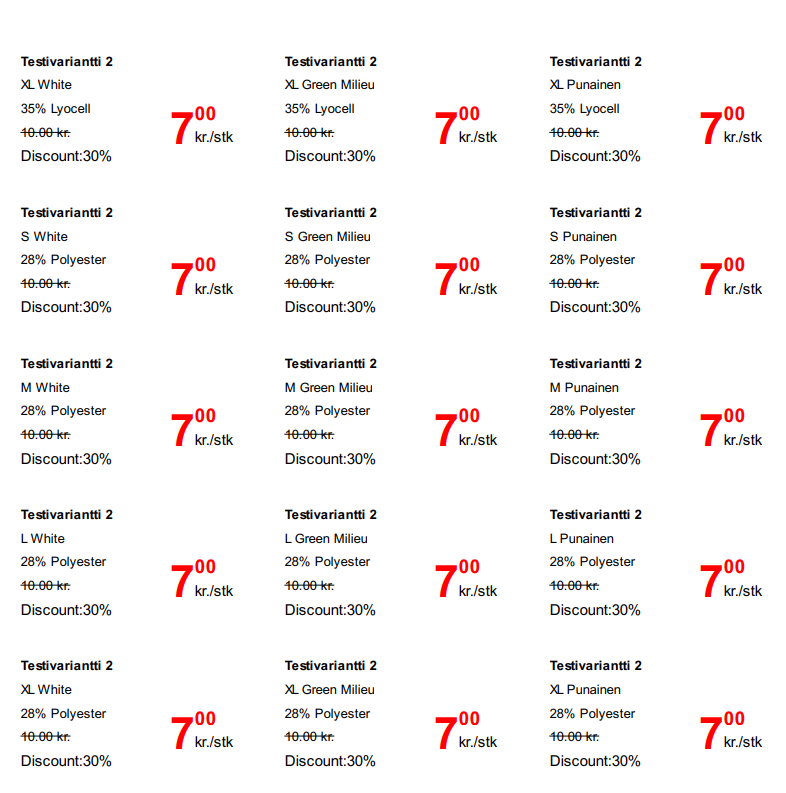Release Notes 05/2024
To promote clarity and usability, the term capacity used in Product Management has now been replaced with net content. The change is visible in both Back Office and POS user interfaces.
Pay at Table Integration
Pay at Table feature is introduced in this release. The feature can be used with Verifone VX690 & V400 payment terminals, and requires WLAN connection. See Enabling Pay at Table for information on how to configure the feature into use.
More than one payment can be made for a single order with a Pay at Table payment terminal. However, it is not possible to make payments for the same order in both POS and Pay at Table payment terminal.
Cancelling or correcting card transactions is not supported when using Pay at Table; these must be done in a POS with a Verifone payment terminal.
See the videos below for examples on how to use the feature (turn closed captions on for detailed descriptions).
https://www.youtube.com/watch?v=hyIWCDfJheg&t=10shttps://www.youtube.com/watch?v=8zTtR_ZTUlE
Inventory with Two Units
Certain products may typically have both base unit and net content defined for them; for example, a wine bottle may have pcs/btl as its base unit and 75 cl as its net content. Now it is possible to use either one in Inventory.
For example: If there are 4 whole bottles (= pieces) and one opened bottle which is not full, you can enter it in inventory as 4 btl, 25 cl rather than 4.33 btl.

Entering an inventoried product using two units
Only the base unit format is displayed in the Products section of the inventory.

Updated product information in inventory
Shelf Label Improvements and Shelf Label Printing for Variant Products
Shelf Labels is now possible for variant products (in addition to basic products).
Shelf labels will be printed for all variants every time.
In addition, discounts can now be displayed in the shelf labels (for both basic and variant products), depending on the used template.
Prices can now also be displayed in Swedish krona (SEK) and Danish krone (DKK).

Example variant product shelf labels with discounts
Setting Validation On/Off for Company Customer Tax Codes
You can now select whether tax codes should be validated when adding new company customers or not; make the selection by clicking the Validate tax codes for company customers switch to ON or OFF position in Company Configurations.

Other Improvements and Fixes
All values in the Products section of Inventory are now displayed in display units.

Corrected the following problem:
Users can access the Admin menu in Kiosk by quickly pressing 3 times in the upper-left corner of the Kiosk application. A PIN code window appears, and the user needs to input PIN code in to access further options.
The user could input any string of characters from the keyboard and still get into the Admin menu; PIN code was not verified in the process.
Now when submitting incorrect PIN code, the application notifies the user that the PIN code is incorrect and does not let user past the PIN code window.
Corrected the problem which in some cases caused free texts added to a receipt show up on all kitchen printouts afterwards, even when in POS the order was displayed as Sent to Kitchen. The problem appeared when Cancelling Orders Sent to Kitchen was enabled in Store Configurations.
Corrected the problem which appeared when an order which had been already sent to the Kitchen was modified in POS: Changing only the ingredients/ingredient options or extra ingredients did not make the order displayed as Modified in the Kitchen.
The following miscellaneous improvements and corrections have been made to Stock Handling:
Net content units can now be used in Stock In type transactions (in addition to Stock Out transactions):
When the transfer is sent in a package, package and base unit are displayed in the target stock.
When the base unit is used as the transfer unit, only the base unit is displayed in the target stock.
When the net content unit is used as the transfer unit, net content and base unit are displayed in the target stock.
Corrected the following problem: When the stock had a PAR level set with an order unit, Stock In transactions used the the base unit, and not the order unit.
Corrected the following problem: When editing a once saved Stock Out type transaction, an error message was displayed, and the user could not continue it. The problem appeared in Transfer and Loss type transactions, when editing quantity, or when saving units when finishing a transfer.
Corrected the following problem: When accepting a Stock In type transaction, units can be changed to a different package or base units. When changes were made to the packages, then the transfer value was incorrect, or when units were changed to base units, the transaction could not be completed.
Corrected the following problem: When exporting Stock Transactions list in Excel format, the Reason Code column displayed empty fields.
Corrected the problem which in some cases prevented a stock item from being added to a stock transfer. The issue was due to discrepancies between the used base units between different stocks.
Corrected the problem which in some cases prevented editing stock item quantities in Stock Out transactions.
Corrected the problem which appeared in in some cases in Stock In type transactions: The expected quantity was counted based on the wrong package and was therefore incorrectly displayed, or caused the expected quantity to be displayed as NaN. In both cases the transfers were correct.
User Manual Updates
The following new pages have been added to the user manual:
In addition, pages which detail Integrations using Solteq Cloud Connector have now been added the manual.
Contact Solteq Sales for more information about integrations using Solteq Connector.
